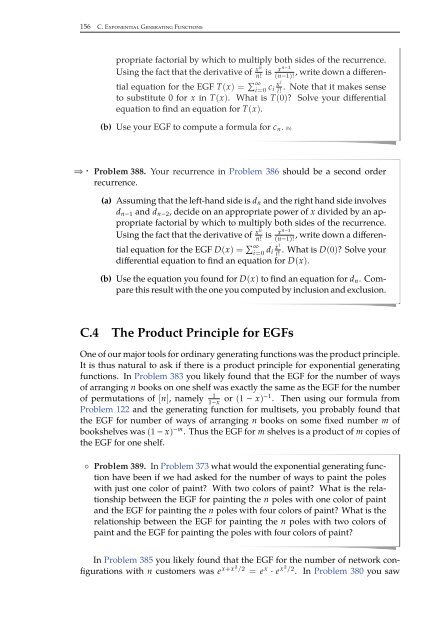Combinatorics Through Guided Discovery, 2004a
Combinatorics Through Guided Discovery, 2004a
Combinatorics Through Guided Discovery, 2004a
You also want an ePaper? Increase the reach of your titles
YUMPU automatically turns print PDFs into web optimized ePapers that Google loves.
156 C. Exponential Generating Functions<br />
propriate factorial by which to multiply both sides of the recurrence.<br />
Using the fact that the derivative of xn xn−1<br />
n!<br />
is<br />
(n−1)!, write down a differential<br />
equation for the EGF T(x) = ∑ ∞<br />
i=0 c i xi<br />
i!<br />
. Note that it makes sense<br />
to substitute 0 for x in T(x). What is T(0)? Solve your differential<br />
equation to find an equation for T(x).<br />
(b) Use your EGF to compute a formula for c n . (h)<br />
⇒ ·<br />
Problem 388.<br />
recurrence.<br />
Your recurrence in Problem 386 should be a second order<br />
(a) Assuming that the left-hand side is d n and the right hand side involves<br />
d n−1 and d n−2 , decide on an appropriate power of x divided by an appropriate<br />
factorial by which to multiply both sides of the recurrence.<br />
, write down a differen-<br />
Using the fact that the derivative of xn<br />
n!<br />
tial equation for the EGF D(x) = ∑ ∞<br />
is<br />
xn−1<br />
(n−1)!<br />
i=0 d i xi<br />
i!<br />
. What is D(0)? Solve your<br />
differential equation to find an equation for D(x).<br />
(b) Use the equation you found for D(x) to find an equation for d n . Compare<br />
this result with the one you computed by inclusion and exclusion.<br />
C.4 The Product Principle for EGFs<br />
One of our major tools for ordinary generating functions was the product principle.<br />
It is thus natural to ask if there is a product principle for exponential generating<br />
functions. In Problem 383 you likely found that the EGF for the number of ways<br />
of arranging n books on one shelf was exactly the same as the EGF for the number<br />
of permutations of [n], namely 1<br />
1−x or (1 − x)−1 . Then using our formula from<br />
Problem 122 and the generating function for multisets, you probably found that<br />
the EGF for number of ways of arranging n books on some fixed number m of<br />
bookshelves was (1 − x) −m . Thus the EGF for m shelves is a product of m copies of<br />
the EGF for one shelf.<br />
◦ Problem 389. In Problem 373 what would the exponential generating function<br />
have been if we had asked for the number of ways to paint the poles<br />
with just one color of paint? With two colors of paint? What is the relationship<br />
between the EGF for painting the n poles with one color of paint<br />
and the EGF for painting the n poles with four colors of paint? What is the<br />
relationship between the EGF for painting the n poles with two colors of<br />
paint and the EGF for painting the poles with four colors of paint?<br />
In Problem 385 you likely found that the EGF for the number of network configurations<br />
with n customers was e x+x2 /2 = e x · e x2 /2 . In Problem 380 you saw


















